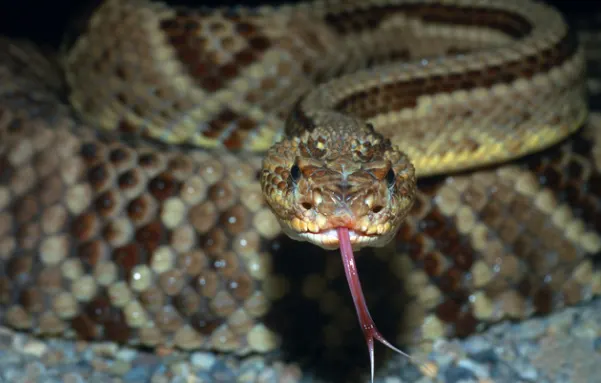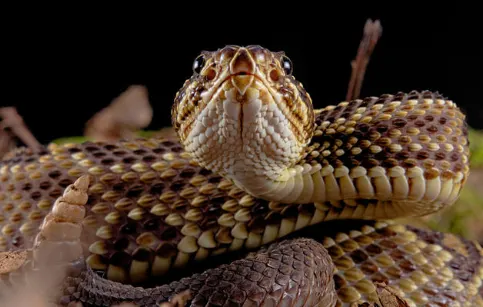The cascabel, also known as the South American rattlesnake, is a fascinating creature found throughout Central and South America. This snake is known for its distinctive rattle, potent venom, and striking appearance. Let’s dive into some interesting facts about this tropical rattlesnake.

Table of Contents
Quick Facts About the Cascabel
- Scientific Name: Crotalus durissus
- Common Name: South American rattlesnake, tropical rattlesnake, neotropical rattlesnake
- Habitat: Dry lowlands, scrublands, savannas, and drier mountain slopes
- Diet: Carnivorous, feeding primarily on small rodents, lizards, and birds
- Lifespan: 10 to 25 years
- Venomous: Yes, and quite dangerous
- Size: Typically 4.9 to 6.2 feet long
4 Fascinating Facts About the Cascabel
- Potent Venom: The cascabel’s venom is extremely powerful. Interestingly, the venom of baby cascabels is even more potent than that of adults, though they produce less of it.
- Unique Head Shape: The venom glands in the cascabel are so large that they give the snake’s head a distinct triangular shape.
- Camouflage Skills: These snakes rely on their excellent camouflage to avoid predators. If that doesn’t work, they use their rattles as a warning.
- Painkiller Potential: A component of the cascabel’s venom, crotamine, is being studied for its potential as a painkiller. It’s said to be 30 times more potent than morphine.
Where Can You Find Cascabels?
Cascabels are native to Central and South America. They can be found in countries like Brazil, Venezuela, Colombia, and even on some Caribbean islands like Aruba. They prefer dry environments, such as scrublands and savannas, and are also found on the drier slopes of mountains.
The Different Types of Cascabel
There are seven subspecies of the cascabel, each with slight variations in appearance and habitat. Some of these include:
- C. d. durissus: The nominate species, found in French Guiana, Guyana, and Suriname.
- C. d. terrificus: Found in southeastern Peru, Bolivia, Paraguay, Uruguay, and northern Argentina.
- C. d. cumanensis: Found in the dry lowlands of Venezuela and Colombia.
These subspecies can be distinguished by the patterns on their scales and the number of scales they have, as well as their specific geographic locations.
What Does the Cascabel Look Like?
The cascabel is a large, thick-bodied snake, usually about 5 feet long but sometimes growing over 6 feet. Its body is adorned with beautiful diamond-shaped patterns, and its ground color can range from shades of brown to gray, including green-gray, blue-gray, or black. The snake’s scales resemble beadwork, and it has a pronounced ridge along its spine, especially near the tail.
The head of the cascabel is also marked with stripes, and the snake’s belly is pale with gray spots that darken near the tail. Its eyes have vertical pupils, and its rattles are uniquely shaped compared to those of other rattlesnakes.
How Dangerous is the Cascabel?
The cascabel’s venom is more dangerous than that of rattlesnakes found further north. While this snake is not aggressive and prefers to avoid conflict, it will bite if threatened. Its venom is primarily neurotoxic, meaning it can paralyze the respiratory system, making it potentially deadly if not treated promptly.
How Do Cascabels Behave Around Humans?
Despite its potent venom, the cascabel is not usually aggressive toward humans. It’s a nocturnal hunter, most active at dusk and dawn. Like other pit vipers, the cascabel has heat-sensing pits between its eyes and nostrils, allowing it to detect prey even in complete darkness. It also uses vibrations to sense the presence of predators or prey.
When threatened, the cascabel may rattle its tail as a warning or even eject a foul-smelling liquid from its cloacal gland. It tends to avoid extreme temperatures, hiding under rocks or in burrows during the hottest parts of the day.
The Cascabel’s Reproduction and Life Cycle
Cascabels mate in the fall, with males often competing for a female’s attention. The female gives birth to live young, usually between four to 10 baby snakes, though as many as 33 have been reported. Interestingly, the babies develop inside eggs with soft membranes within the mother’s body, hatching inside her before being born.

The Evolution of the Cascabel
Rattlesnakes, including the cascabel, are native to the Americas. They can be found from southern Canada all the way to central Argentina. Most rattlesnakes prefer arid environments, though there are exceptions. Theories suggest that snakes evolved from burrowing or aquatic lizards around the Jurassic or Cretaceous period.
The cascabel is a remarkable snake, known for its potent venom, distinctive appearance, and wide distribution across Central and South America. While it may be dangerous, it’s also a vital part of the ecosystem, helping to control populations of small mammals and other prey. Understanding and respecting this snake is key to coexisting with it in its natural habitat.
- Enchi Ball Python: A Unique and Stunning Morph of Python regius - March 27, 2025
- Emerald Tree Monitor: The Enigmatic Green Guardian of the Rainforest - March 26, 2025
- The Egyptian Cobra (Naja haje): A Fascinating Serpent - March 25, 2025
